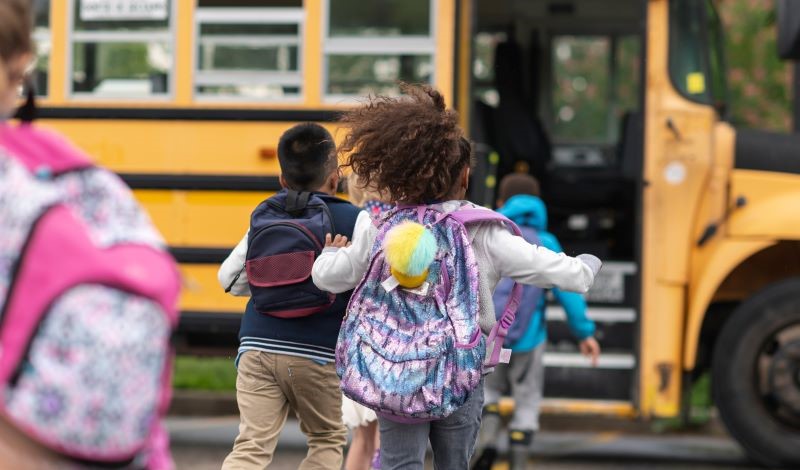
School transportation resources must increase to achieve mobility justice.
The landscape of public schools in the United States has changed dramatically over the past half-century, especially with the advent of school choice. But state policies around student transportation to school largely have not.
In all 50 states, school attendance is compulsory. Furthermore, education has long been viewed as a key pathway to social and economic mobility. To advance social equity, it is essential that students can get to school. School transportation policy, however, is not responsive to existing geographic and socioeconomic inequalities. Mobility justice—a requirement for social mobility—offers a framework for reimagining school transportation regulations to provide students with more equitable access to schools.
Unified school districts across the United States have been predicated on students’ ability to access schools through transportation. Motorized vehicles, such as the yellow school bus, made it possible for students to attend schools much farther away than walking distance from their homes. Transportation thus made it possible for districts to group students from broader territories into unified school districts. States responded by authorizing or compelling districts to bus students to their schools.
The federal government relegates most education policy to the states, including school transportation. States set minimum education standards which districts must adhere to, including for transportation. Traditionally, these standards have focused on the distance students live from their assigned schools—typically one to three miles minimum to receive bus service.
When it comes to school transportation, states can mandate that districts provide it and determine who is eligible for it. States can also provide districts with funding, regulate permissible vehicles and decide if districts can charge fees for bus use. Providing service is usually a district role. State transportation funding is typically based on the distance transported students travel or the operating costs that districts incur in providing the service.
For decades, these policies generally worked: Most students lived near their schools, and districts bused those who did not. In 1969, nearly half of all students walked or biked to school, while 38 percent arrived by school bus and 12 percent arrived by car. But school siting and choice options have changed in the subsequent half century. Districts now tend to build schools on the fringes of developed areas, where land for athletic fields and parking lots is cheap. And school choice programs that parents can select for their children’s education—intra-district, inter-district, and charter schools—have grown since the 1990s. Of further concern, many states exempt choice program students from transportation policies. Perhaps consequently, students today live further from school than in 1969. Over half arrive by car; 37 percent arrive by school bus; and just 11 percent walk or bike.
For those who receive transportation, school bus systems are typically structured so that many children from neighborhoods near a school all board buses that then converge on that school. Although this structure worked for decades, today, students from a single neighborhood are likely not only to live further from their nearest school but also to attend a wider variety of schools, largely due to school choice policies.
Although the need for the school bus has likely only increased with school choice policies, the percentage of students who use bus transportation has remained stagnant. This suggests that the old model is not oriented toward the new reality of many more students attending dispersed schools far from home. School transportation resources and policies have not kept pace with the needs of students.
Some new transportation models have emerged, particularly those of alternative transportation companies such as HopSkipDrive, which arranges rides with independent contractor drivers using private vehicles. Another example is Zum, which deploys a fleet of vehicles ranging from passenger cars to traditional yellow school buses. Some states’ regulations, however, restrict the types of vehicles that districts can use to transport students, precluding the use of these services to supplement bus service.
Furthermore, public schools are still deeply racially segregated, and a family’s ability to move to areas with greater social and economic opportunity is politically and economically constrained. Transforming school transportation policies to ensure mobility justice and, in turn, increased opportunity for social mobility will require regulation that is responsive to the unequal geographic and social landscape in which children attend school.
Key to achieving mobility justice in education is acknowledging how familial, community, social, and policy resources for getting to school are uneven. State and federal law generally requires and funds districts to provide transportation for students who are unable to walk to school due to distance, who have disabilities, who are homeless, or who are in foster care. These provisions acknowledge that some students have greater need for school transportation than others. But they do not go far enough in responding to the unequal distribution of transportation resources and barriers across student groups.
Children from low-income or racial minority communities are more likely to live in areas that have closed many neighborhood schools and expanded school choice. And, while some cities have charter schools scattered throughout the region, in cities like Detroit, charter schools are often located further from the neighborhoods where most students live.
In nearly all cities, public transit insufficiently handles these trips and takes too long. And low-income families are less likely to own a car to help transport their children to a school at which they are not transportation-eligible. The bottom line is that some students have greater need for school-provided transportation than others, but the law is silent on how jurisdictions should manage this unevenness.
In an era of widespread school choice, expanding access to school enrollment only expands educational opportunity if students can get to the schools their families choose. Without parallel expansion of transportation resources, school choices are limited to those who are already advantaged.
Although matching school choice options with equally robust transportation resources may be one path toward greater equity, most families across race and class want high quality schools, close to home. In this way, mobility justice for educational equity might also involve greater investment in neighborhood school quality and safe routes to school. It may also include greater coordination between educational, governmental, and commercial entities to align work schedules and childcare needs among working parents. It will also likely need new state school transportation regulations that require districts to expand transportation eligibility and provide more flexible funding to accommodate differences in student need.
Policies for providing school transportation worked for decades, and they continue to work for many students. The shifting landscape of schools and student needs, however, have left many families without a means of getting children to school. Working toward mobility justice for these students will require listening to families about what they need and want, adapting school transportation policies, and furthering efforts to improve nearby schools for all students.
This essay is part of a four-part series entitled, Mobility Justice.





